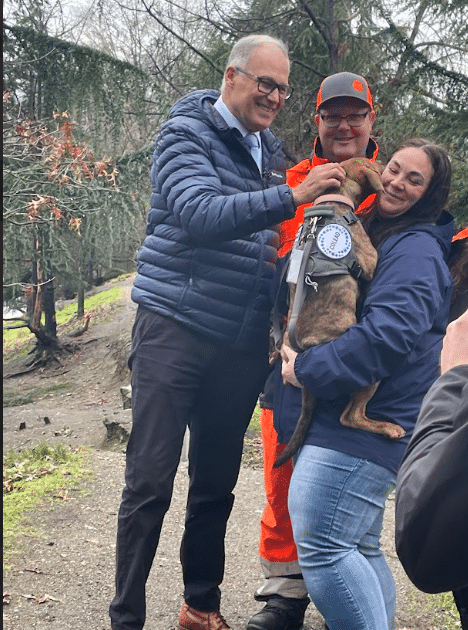How does an encampment get resolved, and resolved well, without displacement or chaos?
Months of work. Hours of trudging up worn paths with bags of muffins and supplies. Smiling until the muscles in your face scream.
But this human being, living unsheltered in the mud churned under their feet, has a connection with you now. And that smile you share is a symbol of that relationship built over time and bulk store supplies and the chance that you’re able to offer them to see a different future for themselves.
“It’s challenging work to be doing daily,” said Nichole Alexander, director of Special Initiatives and Outreach with Purpose. Dignity. Action. (PDA).
That isn’t what people see when the cameras gather on the curb overlooking the I-5, surrounding the governor who is there to make the case for more funds so that the hard work can continue. That’s the work that outreach teams at PDA and REACH do every day.
Also a puppy named Itsy Row.

On Wednesday, Feb. 21, Gov. Jay Inslee, the Washington State Department of Transportation (WSDOT), PDA, REACH, and the King County Regional Homelessness Authority (KCRHA) met with reporters to talk about the resolution of a prominent encampment off of the freeway. It had recently garnered media attention because of a shooting that left a man alive but with a leg wound. Now it was gone.
Of the people living there, 28 came inside, one of whom is in hospice care. Only two declined help–confirmation that generally, people living outside aren’t “service-resistant,” so long as the services we offer them are appropriate for their situation. Another eight left before outreach workers could connect with them.
This was the work of the Right of Way Initiative (ROW), a coalition of state (WSDOT, Washington State Patrol) and local (KCRHA) agencies and care providers (PDA, REACH), that the state convened in 2022 to help remove encampments that formed along major roads on property owned by WSDOT. The idea was that those folks were in a special danger because they lived next to cars going at top speed, and they also presented a danger to those vehicles if a tent blew onto the road or their presence there contributed to an accident of some kind.
While lawmakers are still in session and the new state budget is still in flux, Inslee has been making the rounds to argue for ROW because it is effective at breaking up such encampments and preventing them from forming again. It’s a multi-pronged process: bring people inside, get them the help that they need, and also return areas to their original purpose, start/finish construction work, or open areas back for public use.
“This is not something we can do for free, but it is a good investment,” Inslee told reporters.